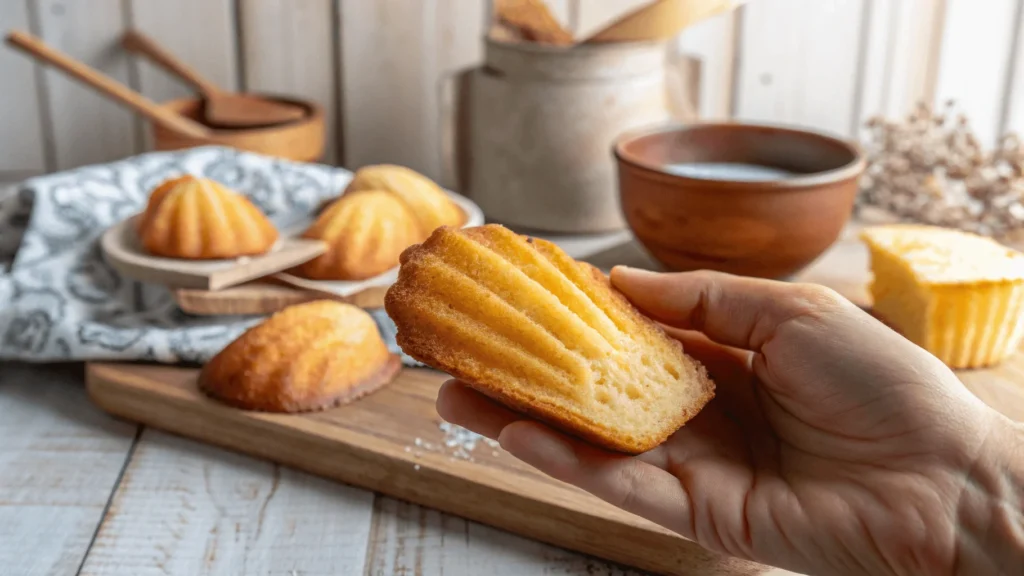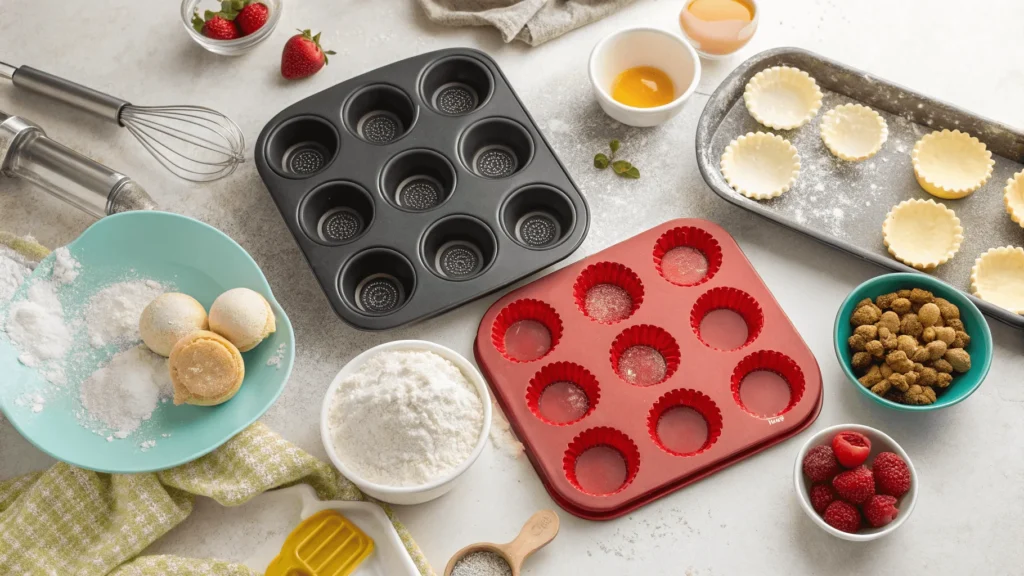Madeleine molds have been a staple in French baking for centuries. These small, shell-shaped pans are key to creating the perfect Madeleine, a traditional cake that is light, airy, and delicious. However, not everyone has access to a Madeleine mold, or they may prefer alternatives for various reasons. In these cases, Madeleine mold substitutes offer a great solution. Understanding how to choose the right substitute can be essential for achieving a similar result without compromising the quality of your baked goods. This article will guide you through everything you need to know about Madeleine molds, why substitutes might be necessary, and how to use them effectively.
What are Madeleine Mold Substitutes and Why Are They Used?
Madeleine molds are specialized baking pans designed to shape the batter into distinctive shell-like cakes. Traditionally made from metal, these molds are known for their deep, curved cavities that give Madeleines their signature shape. The molds are not only functional but also an essential tool for achieving the ideal texture and appearance. Without a proper mold, it can be difficult to replicate the unique structure of Madeleines.
While traditional molds are popular, they are not always accessible or convenient. That’s why understanding why and when you might need a substitute is important. With the right alternative, you can still achieve a delicious batch of Madeleines without compromising on taste or texture.
Madeleine mold substitutes are tools that can replicate the shape and texture of traditional Madeleine pans. These substitutes allow you to bake Madeleines without the specialized pan, offering an opportunity for versatility in your baking.
Key Features of Madeleine Mold Substitutes
Madeleine molds are known for several key features that contribute to their ability to bake perfect Madeleines. These molds are specifically designed to shape the batter in a way that results in a cake with a slightly crisp exterior and a light, fluffy interior. The shell shape allows for even heat distribution, which is essential for getting the right texture.
Shape, Size, and Material of Madeleine Mold Substitutes
The traditional Madeleine mold is designed to create small, shell-shaped cakes with distinct ridges. The shape of the mold helps the batter rise evenly and cook through without becoming overly dense.
Madeleine molds come in various sizes, typically ranging from small to medium, with cavities designed to hold about one to two tablespoons of batter. The most common material for these molds is metal, though silicone and ceramic options are also available. Metal molds tend to offer the best results in terms of even heat distribution and a golden crust.

Types of Madeleine Molds
- Metal Molds: These molds are often made of stainless steel or aluminum. They are durable, and they conduct heat well, allowing for consistent baking. Metal molds also offer a crispier finish.
- Silicone Molds: Silicone molds are flexible and non-stick, making them convenient to use and easy to clean. While they provide a slightly different texture, they can still yield excellent results with the right baking technique.
- Ceramic Molds: These molds are less common but can still be found in certain specialty shops. They offer a sturdy, heat-retaining option that bakes Madeleines evenly.
When using substitute molds, it’s important to consider the differences between Financiers and Madeleines, as certain molds or techniques may affect the traditional texture of Madeleines.
Why Do You Need a Substitute for Madeleine Molds?
There are several reasons why you might need an alternative to Madeleine molds. Whether you’re lacking the traditional pan, or you’re simply looking for a more versatile baking option, knowing when and why to opt for a substitute can be crucial.
When and Why Would You Need a Madeleine Mold Substitute?
At times, finding the ideal Madeleine mold can be difficult. Maybe you don’t have one on hand, or you’re looking for an easier solution. In these cases, alternatives to traditional molds can still provide an excellent outcome. Choosing a substitute often depends on the tools you have available and the desired outcome.
Some people may need a substitute because they can’t find a Madeleine mold in stores or they may not want to buy a specialized pan for just one recipe. Others might need an alternative to create different shapes or to experiment with textures.
Common Issues with Traditional Madeleine Molds
Traditional Madeleine molds come with a few challenges. These include:
- Difficulty in Removing the Cakes: Sometimes, the batter can stick to the mold, making it challenging to remove the finished Madeleines without damaging them.
- Size Constraints: Traditional molds are usually designed for a specific portion size. This can make it difficult to bake in bulk or adjust the size according to personal preference.
- Storage: Some bakers may find storing these molds cumbersome, especially if they bake infrequently or lack kitchen space.
Benefits of Finding a Suitable Substitute
When you choose the right substitute for your Madeleine mold, you can enjoy several benefits. These include:
- Flexibility: Many substitutes offer more flexibility in terms of portion sizes and shape customization.
- Accessibility: Common kitchen items like muffin tins or cupcake pans can serve as excellent alternatives to Madeleine molds, making it easier for everyone to try their hand at this French classic.
- Creativity in Baking: Substitutes allow for more experimentation with different shapes and sizes, which can result in a fun and innovative twist on the classic Madeleine.
If you’re wondering how to adapt recipes without sacrificing texture, learning how to keep Madeleines moist is an essential tip for perfecting your bake using alternative tools.
Common Substitutes for Madeleine Molds
If you don’t have a Madeleine mold on hand, don’t worry—there are several effective alternatives you can use that will still allow you to create delicious Madeleines in your kitchen. Each of these options not only provides a practical solution but also offers unique advantages depending on the materials available and your individual baking preferences. Whether you’re looking for flexibility in portion sizes, ease of use, or simply a way to experiment with different shapes, these substitutes can help you achieve delightful results without compromising on flavor or texture.
5 Popular Alternatives to Madeleine Molds
These five substitutes can effectively replicate the look and texture of traditional Madeleine cakes when used correctly, allowing you to enjoy this classic French treat even without the specialized pan.
Muffin Tins as a Madeleine Mold Substitute
Muffin tins are one of the most common substitutes for Madeleine molds and are often found in most kitchens. Although they don’t possess the distinctive shell shape characteristic of Madeleines, they can still hold the batter and bake it into an equally delicious cake. The versatility of muffin tins allows for various portion sizes, making them an excellent choice for those who want to experiment with different serving options. Additionally, using muffin tins can simplify the baking process, as they are easy to handle and clean, making them a practical alternative for both novice and experienced bakers alike.
Pros and Cons of Using Muffin Tins for Madeleine Recipes
Pros:
- Easily Accessible: Muffin tins are a staple in most kitchens, making them readily available for bakers. Unlike specialized Madeleine molds, which may require a trip to a specialty store, muffin tins can typically be found in any home, allowing for immediate use whenever the craving for Madeleines strikes.
- Versatile for Other Types of Baking: One of the significant advantages of muffin tins is their versatility. They are not only suitable for baking Madeleines but can also be used for a variety of other recipes, such as muffins, cupcakes, and even savory dishes like mini quiches. This multifunctionality makes them a valuable addition to any kitchen, providing more opportunities for creativity in baking.
- Ease of Use: Muffin tins are generally straightforward to use, making them an excellent option for novice bakers. Their familiar design allows for easy batter pouring and portion control, ensuring that each baked good is uniform in size.
- Convenient Cleanup: Most muffin tins are designed to be non-stick, which simplifies the cleanup process after baking. This feature can save time and effort, allowing bakers to enjoy their treats without the hassle of extensive cleaning.
Cons:
- Shape Differences: The primary drawback of using muffin tins is that the shape differs significantly from traditional Madeleine molds. This difference can affect not only the visual appeal but also the texture of the final product. The absence of the distinctive shell shape may lead to a less authentic Madeleine experience.
- Texture and Appearance: Due to the varied depth and width of muffin tins compared to Madeleine molds, the resulting cakes may not achieve the same lightness or airy quality typical of Madeleines. The unique design of traditional molds helps create a slightly crispier exterior and a tender interior, qualities that may be compromised when using muffin tins.
- Potential for Less Crispiness: Muffin tins may not provide the same level of crispiness on the edges as traditional Madeleine molds do. The heat distribution and the shape of the mold play crucial roles in achieving that perfect golden crust, which might be lacking when using a muffin tin.
Mini Bundt Pans as a Madeleine Mold Substitute
Mini Bundt pans are another great substitute for Madeleine molds. These pans have a more rounded, fluted shape, which can mimic the classic shell-like form of the Madeleines.
How Mini Bundt Pans Mimic the Shape of Madeleine Molds
The ridged design of mini Bundt pans offers a similar texture and visual appeal to Madeleine molds. They create a slightly larger, more substantial cake but still maintain the necessary rise and crisp edges.
Cake or Brownie Pans as Madeleine Mold Alternatives
If you’re looking for an easy alternative, cake or brownie pans can be used to bake Madeleines in a flat, rectangular shape. This is especially useful if you don’t have smaller, specialized molds.
Adaptations for Baking Madeleines in Flat, Rectangular Pans
- Use a spoon or an ice cream scooper to portion the batter.
- You can cut the baked cakes into individual portions after baking.
Silicone Baking Mats as a Madeleine Mold Substitute
Silicone baking mats provide a non-stick surface for your batter and can be used in a similar manner to silicone molds. They don’t have the specific shell shape but will allow the batter to bake evenly.
How Silicone Mats Can Be Used for Madeleines
Simply pipe the batter onto the silicone mat and bake as directed. This method is perfect for bakers looking for an easy cleanup option.
Tartlet Pans as a Madeleine Mold Substitute
Tartlet pans, which are usually round and shallow, can also serve as a great alternative to Madeleine molds. They can hold individual servings of batter and provide a slightly different shape but similar texture.
Why Tartlet Pans Work Well for Madeleines
The fluted edges of tartlet pans allow the batter to rise and crisp up, resulting in a delicious treat that’s similar to the traditional Madeleine.
For those experimenting with substitutes, exploring the art of making Madeleine cookies with cream can inspire innovative techniques while working with non-traditional molds.

How to Choose the Best Substitute
When selecting a substitutes for Madeleine mold, it’s essential to consider several factors that can affect the outcome of your bake.
Size and Shape Considerations
The size and shape of the mold are crucial to achieving the right texture and appearance. Look for molds that provide a similar depth and width to traditional Madeleine pans.
Matching the Traditional Madeleine Form
When possible, select a substitute with a rounded, shell-like shape. While muffin tins and Bundt pans can work, they may alter the final presentation and texture of your Madeleines.
Material Considerations
Different materials affect how heat is distributed during baking. If you’re using metal, it will heat quickly and evenly, which is ideal for traditional Madeleines. Silicone, on the other hand, offers flexibility but may result in a softer exterior.
Which Material is Best for the Perfect Madeleine Bake?
For a more authentic Madeleine, choose metal or ceramic pans. Silicone is ideal for easy removal but might alter the texture slightly.
Baking Time and Temperature Adjustments
When using substitutes, adjustments in baking time and temperature may be necessary. Some molds may bake faster or slower than traditional Madeleine molds.
How to Adjust Baking for Different Molds
- Increase or decrease baking time based on the material and size of your substitute pan.
- Keep an eye on the cakes as they bake and adjust as needed.
Step-by-Step Guide: Using a Substitute
If you’ve decided to use an alternative to Madeleine molds, follow this detailed guide to ensure you achieve the best possible results when baking. Substituting molds can offer flexibility, but it’s important to adjust your approach to ensure the recipe turns out perfectly, even without the classic Madeleine shape.
Preparing the Molds
Before you begin, make sure to prepare your substitute molds by greasing them lightly. This step helps prevent the batter from sticking and ensures a clean release after baking.
Greasing and Prepping Non-Madeleine Molds for Best Results
Use butter or non-stick spray for greasing. If you’re using silicone molds, this step might not be necessary, but it’s always better to be cautious.
Adjusting the Recipe
Depending on your substitute, you may need to adjust the recipe. For example, if you’re using a muffin tin or cake pan, you may need to modify the baking time.
Modifications for Substituting Molds in Madeleine Recipes
- For muffin tins, reduce the amount of batter for each cup to achieve a similar size.
- Adjust baking time to ensure the cakes bake evenly and fully.
Frequently Asked Questions (FAQs)
Can I use regular cake pans for madeleines?
Yes, you can use regular cake pans, but the shape and texture may vary. You might need to adapt the recipe and bake for longer.
Will the texture change when using substitutes?
Yes, the texture might differ slightly, especially if you’re using a pan with a different shape. The Madeleines may not have the same crisp edges or shell-like form.
How can I prevent sticking when using substitutes?
Greasing the molds thoroughly and using parchment paper can help prevent sticking, ensuring easy removal.
Are silicone molds better than metal molds for madeleines?
Silicone molds offer easy removal and flexibility but may not provide the same crisp exterior as metal molds.
Can I use cupcake liners as a substitute?
Cupcake liners can work in a pinch, but they may not give you the same shape or texture as traditional Madeleine molds.
Do I need to adjust the baking time?
Yes, baking time may need to be adjusted when using different molds. Keep a close eye on your Madeleines as they bake.

Conclusion
Finding the perfect substitute for Madeleine molds doesn’t have to be a complicated task. With the right tools, a bit of creativity, and some flexibility in your approach, you can still enjoy these delicious French treats without the need for a specialized pan. If you don’t have traditional Madeleine molds available, don’t worry—there are many other alternatives that can yield similar results. Muffin tins, mini Bundt pans, and tartlet pans all work well as alternatives, giving you different shapes and sizes for your Madeleines. The key is to adjust your baking techniques to accommodate the new molds, ensuring that your treats turn out perfectly.


1 thought on “How To Make Madeleine Cakes Without A Traditional Madeleine Mold”